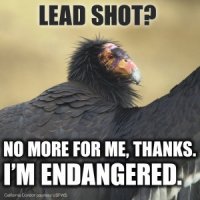
Lead is toxic. It poisons humans and wildlife alike. So why is lead ammunition still allowed in California?
Right now, Governor Jerry Brown is considering whether or not to sign a bill passed by the California Legislature to ban lead ammunition in hunting in the state. He should do the right thing by signing AB 711 into law.
Lead is a known toxin that has already been removed from nearly everything including paint, gasoline, and pencils. But it persists in ammunition, threatening California condors, mountain lions, bald eagles and golden eagles among others.
Lead poisoning in the endangered California condor is now of “epidemic proportions”:
There are currently only 224 California condors in the wild, spread across Arizona and Mexico as well as California. (Almost half the population lives in California). The birds are North America’s largest land birds, with wingspans reaching nine feet or more. Their much-celebrated comeback–they were down to 22 birds in 1982 before a captive-breeding program boosted their numbers–belies their tenuous status.
While hunting endangered species like the California condor is clearly illegal, they ingest spent lead ammunition which causes painful, deadly lead poisoning in 130 species of birds and animals. Millions of non-target birds and other wildlife are poisoned each year in the U.S. from scavenging carcasses containing lead-bullet fragments, eating lead-poisoned prey, or ingesting spent lead-shot pellets, mistaking them for food.
Co-sponsored by Audubon California, the Humane Society of the United States, and Defenders of Wildlife, and authored by Assemblyman (and former interim Executive Director of CLCV) Anthony Rendon, AB 711 aims to protect wildlife and the environment. But it will also protect those who hunt and those who eat hunted game in California from ingesting lead themselves.
Dozens of hunters have signed on to a public letter of support for the bill noting that using lead ammunition despite the risks to wildlife and public health “is at odds with the proud tradition of responsible hunting stewardship.” Signers include Michael Sutton, president of the California Commission on Fish and Game, and vice president Richard Rogers.
Science rather than political considerations should drive the governor’s decision. A consensus statement signed by 30 scientists and published in Environmental Health and Perspectives says “lead-based ammunition is likely the greatest largely unregulated source of lead that is knowingly discharged into the environment in the United States”:
Lead is one of the most studied toxicants, and overwhelming scientific evidence demonstrates that lead is toxic to several physiological systems in vertebrates, including the nervous, renal, cardiovascular, reproductive, immune, and hematologic systems. Furthermore, there is no level of lead exposure in children known to be without adverse effects.
In light of this evidence, there is an urgent need to end a major source of lead for animals and humans: spent lead bullets and shotgun pellets. Notably, production of lead-based ammunition in the United States accounted for > 69,000 metric tons consumed in 2012; this is second only to the amount of lead used to manufacture storage batteries.
According to Defenders of Wildlife:
More than fifty years of scientific research has shown that the presence of lead in the environment poses an ongoing threat to the health of the general public and the viability of the state’s wildlife, including federally listed endangered species such as the California condor, and countless other species such as golden eagles, mourning doves and our national symbol, the bald eagle. There’s no reason to allow continued dispersal of lead into the environment.
Lead ammunition creates a toxic hazard to animals and humans because the ammunition fragments when it is shot into an animal. Those tiny pieces of lead remain in the animal or the animal parts left behind by hunters, which are scavenged by many species including California condors, bald eagles and golden eagles. It only takes a tiny amount of lead to have a devastating impact, and because lead accumulates each hunting season but never breaks down, each year we are increasing the risks of exposure and poisoning.
In 1991, the U.S. Fish and Wildlife Service required the use of non-toxic ammunition for waterfowl hunting; in 2007, the California Legislature required the use of non-toxic ammunition for big-game hunting within the range of the California condor. AB 711 builds on a decades-long effort to remove toxic lead from our environment. Please tell Governor Brown to protect California’s environment, wildlife, and people, and sign AB 711.


